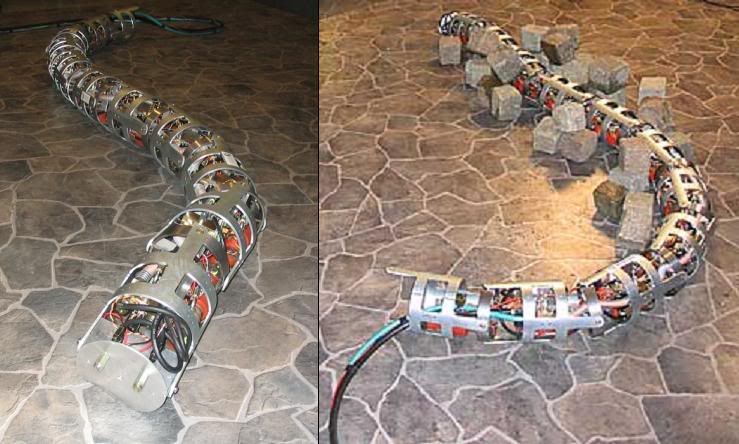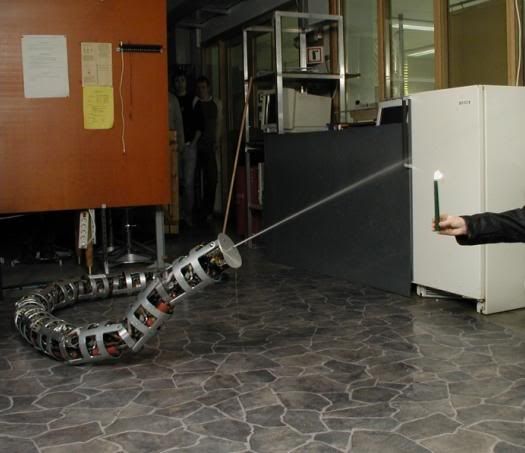I spent the period from about 1992 to 2003 working on the control system for an autonomous snake robot - part of my report on that is still on the web - so I was quite interested to see this today:
It is intelligent and moves with the aid of hydraulic pressure and co-ordinated joint movements. A snake robot can perform life-saving operations during a fire, an explosion and in other hostile environments.
Try to picture a snake-like robot that can move into places that are too dangerous for humans to enter. The snake can climb up stairs, force past beams and twist itself round corners. Imagine that it has a built-in advanced water tap that not only can be turned on and off, but can allow the direction of the water flow to be altered.
 The Anna Konda robot, from the SINTEF labs in Norway, is powered by the 100 bar pressure of the water in the hose it carries. A valve system operates the water hydraulic actuators in the joints. Ten 2-degree-of-freedom joints gives this three meter long robot twenty degrees of freedom of movement. The 100 bar pressure (10MPa or 1500 psi, thereabouts) gives the robot a lot of power for movement, enough that it can drag its hose with it. There are a set of cameras in the front that allow the operators to see the territory immediately in front of the robot.
The Anna Konda robot, from the SINTEF labs in Norway, is powered by the 100 bar pressure of the water in the hose it carries. A valve system operates the water hydraulic actuators in the joints. Ten 2-degree-of-freedom joints gives this three meter long robot twenty degrees of freedom of movement. The 100 bar pressure (10MPa or 1500 psi, thereabouts) gives the robot a lot of power for movement, enough that it can drag its hose with it. There are a set of cameras in the front that allow the operators to see the territory immediately in front of the robot.There is a lot of utility to the snake design. It can get into tight areas, it can climb over obstacles - in nature, snakes can even swim or climb trees. There is every reason to suspect that robotic snakes can operate in and traverse a great many environments. The modular design of a snake robot means manufacturing can take advantage of assembly-line processes - and, if one or several joints sieze up, the robot can still operate reasonably well.

 The number of applications of snake robots is huge. The could be used in space - indeed they already are being used in space, as the Canadarm robots on space shuttles are essentially snakes fixed at one end. I can see them being used on asteroid missions, lunar missions, and assembly of large space stations - either as autonomous vehicles or under direct human control as robotic arms. A similar design could operate under the ice in the oceans of Europa or in the deep sea of Earth..
The number of applications of snake robots is huge. The could be used in space - indeed they already are being used in space, as the Canadarm robots on space shuttles are essentially snakes fixed at one end. I can see them being used on asteroid missions, lunar missions, and assembly of large space stations - either as autonomous vehicles or under direct human control as robotic arms. A similar design could operate under the ice in the oceans of Europa or in the deep sea of Earth..And, the design is scaleable. Nanotech robots, such as ones that would operate in the human bloodstream or that enter and fix human cells, would likely have a snake shape and simply swim around in the water in the body.
The work has so far consumed 18 months and a thesis at SINTEF. A Ph. D study, which is underway at NTNU, is concerned with developing a control strategy for the robot.Hey, I spent thirteen years on this problem already, and I believe my FUNGAL system is perfectly suited to their needs. If SINTEF wants, I can help them out with their control system. Call me.
More on the Firefighting Snakebot can be found here.
Technorati Tags: Robots, Artificial Intelligence,
No comments:
Post a Comment